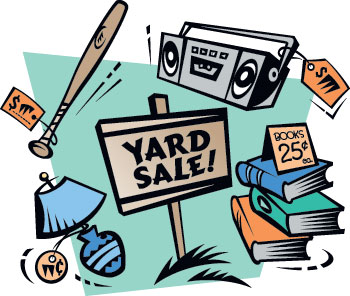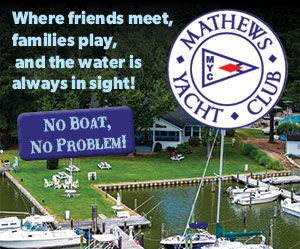In honor of 30 years of The Rivah Visitor’s Guide we are featuring stories that have previously been printed throughout our 30 year history. This feature story appeared in the August 2013 issue.
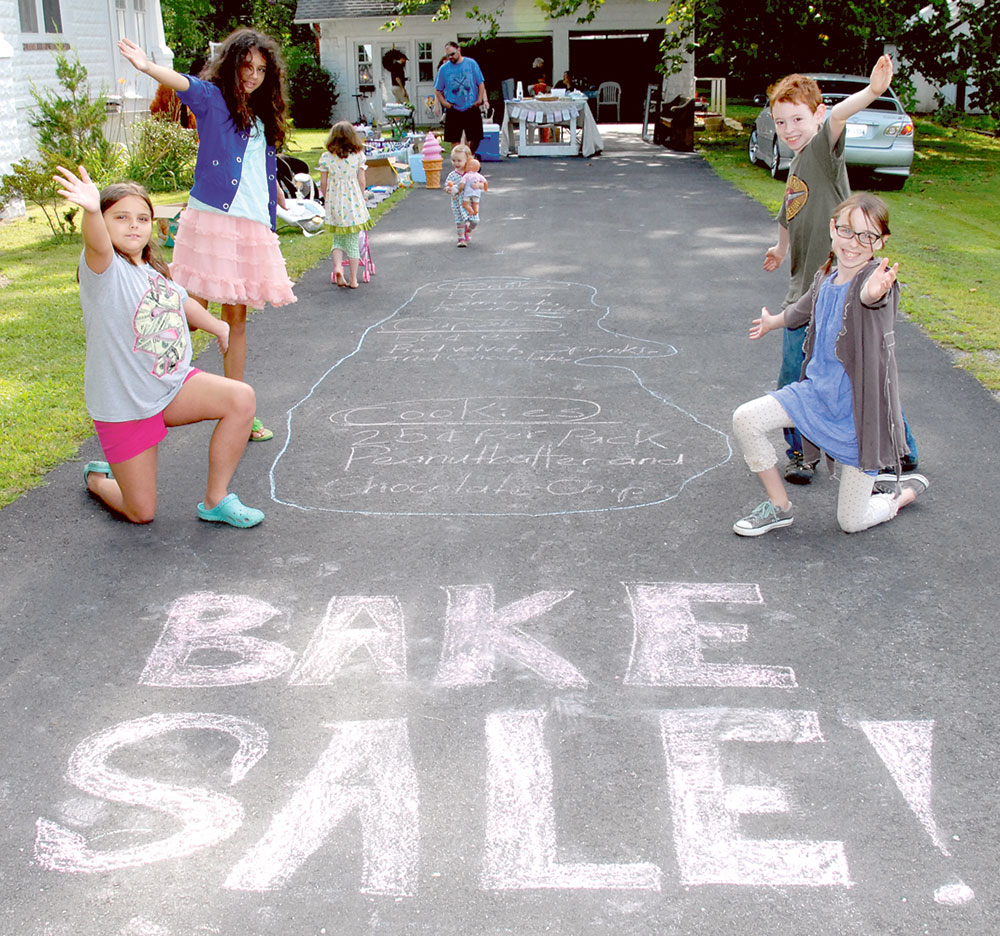
by Tom Chillemi –
A dollar doesn’t buy much any more, but it’s amazing how far your dollars go at yard sales.
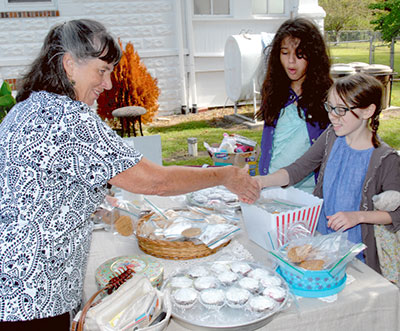
More entertainment than shopping, yard sales are a great way to get out into Rivah communities and meet people.
There’s a spirit of adventure traveling down back roads . . . you never know what you’re going to find. What undiscovered artifacts lie buried amid the leftover scraps?
Columbus probably felt the same as he sailed to the new world.
“A lot of fun”
Ruth Marcellus of Mathews was holding her “last” yard sale in her driveway recently. She was moving to Wisconsin. For her finale—a multi-family yard sale—the children baked cookies and cupcakes and marketed them by listing the menu with chalk on the driveway. (A Mathews woman entices buyers by listing “free ice water” or “lemonade” in her yard sale ads.)
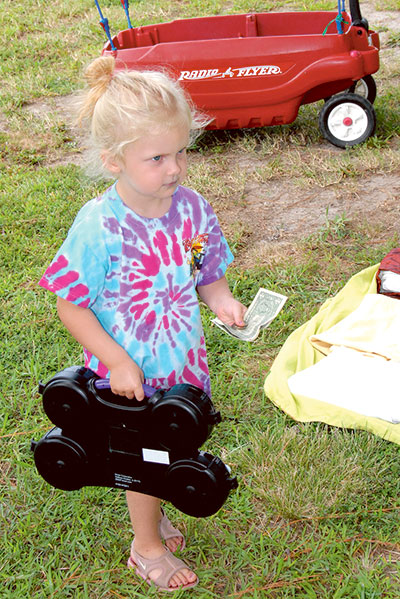
Marcellus is well known for her yard sales. A former nurse, she opened an antique shop so she could stay home with her granddaughter. Every year she’d hold a yard sale, prompted by public demand . . . perhaps for those yard sale prices that make items irresistible
“It’s an excuse,” she said. “I have a lot of fun buying and selling.”
On this Saturday, one of Marcellus’ offerings was an antique radio, with a rare wooden horn speaker, that she’d found in a barn in Wisconsin. The set was marked for $150, and she said she was ready to negotiate. “I start a little bit high, but I make sure I’m lower than the shop price,” she said. “If they don’t like the price, I ask what they think it’s worth . . . and I let them have it. I always make a deal.”
“Deals” she made, in just a few minutes, included recycled toys, an antique steel tractor seat and a cage for her rabbit.
There was a treasure seeker at Marcellus’ yard sale. He pulled out a miniature magnifying glass to examine the stamping on a tarnished napkin holder. “Pewter” was all he said as he laid it back on the table.
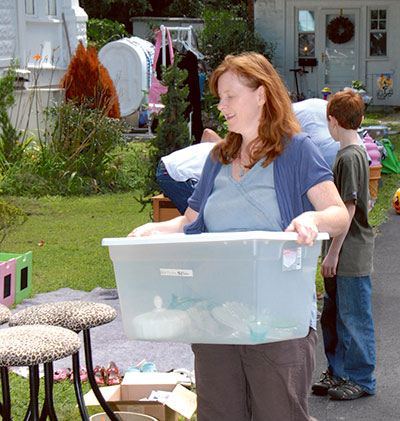
He didn’t know the bargain of the day was down a back road near Cobbs Creek.
He and many others passed on buying the John Barber print of Richmond’s Shockoe Bottom for $25. It looked like a good pick—if you wanted to try and re-sell it in Richmond. When buying items to re-sell, you have to ask: “How much would someone pay?” There’s a saying among pickers, “You make your money when you buy it.”
The beauty of yard sales is there is no mark up—and the price is the best you’re going to get.
“How much have I made?”
Another yard sale sign popped up on Route 14 in Mathews. This one was unadvertised.
Heather Bennett was selling stuff, including toys, to buy school supplies. Her husband, “Bear” Bennett, made a deal on “bundled” items, which included a propane tank and two fishing reels for $10. “I didn’t want the reels; I have the rods in the garage,” he said after the buyer left. “ This is fun. We ought to do this every week.”
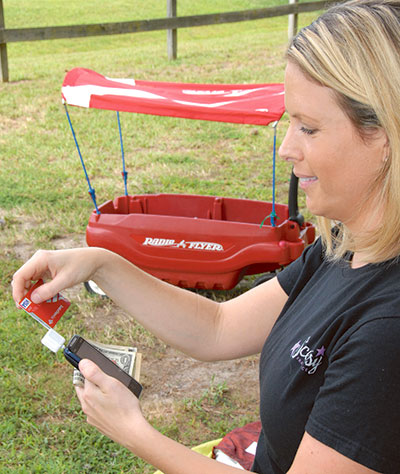
Their son Jake, 10, wanted to know why he couldn’t have the proceeds when his toys were sold. He wasn’t at the yard sale, but called to ask several times, “How much have I made?”
Three-year-old Taylor Hubbard picked an electric drum set for $2. She pretended to play even though it didn’t have batteries. She happily carried it to the car saying she’d take it home “and see what we can do about it.”
The Bennetts’ friend, Andie Teeter, was also selling yard sale items, making a few dollars for a Disney World trip. Teeter had set up her Scentsy scented products, which brought in two buyers. And, here’s a twist, Teeter accepts credit cards via her smart phone.
“Final yard sale”
The find of the day was a few miles up Route 14 and down a twisting side road. It was at another “moving sale,” probably the best place to get bargains, because sellers don’t want to move extra stuff.
A man was walking away empty-handed. “Park right up here,” he said, “They’re bargaining.”
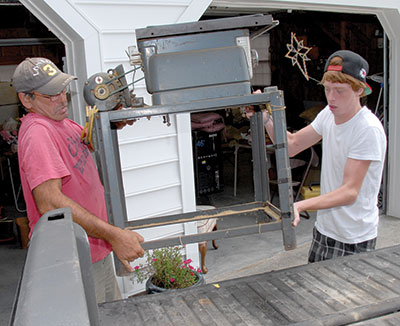
He was a neighbor looking for something free, said the seller. “We didn’t give him anything,” she quipped.
Another man came back to see if the chain saw he was looking at earlier was still available. Sorry, too late, someone offered more than he had offered earlier.
Here at her “final yard sale,” negotiating that bordered on larceny was about to take place. The owner was moving to New Kent. The garage had nearly been picked clean. A Craftsman table saw was in the back. A wood worker told me he’d rather have an old Craftsman table saw than a new one because they are better made.
“This is my last yard sale for the year,” said the man.
I asked, “Why, did you spend your budget?”
His reply, “Yeh, well, and that too.” It made me think he’d accumulated more stuff than he had space.
Comedian George Carlin had a routine about “stuff.” The punch line was, “Stuff expands to fill available space.”
That’s why people eventually have yard sales.
It’s ironic that we work to buy this “stuff.” We use it, store it, then when it has nearly no value to us, we try to sell it for pennies on the dollar. That’s kind of like asking people to pay you to haul away your junk. But, many are happy to do just that.
It’s a great way to spend a Saturday morning at the Rivah. Who knows what you’ll find.
 The Box
The Box
by Tom Chillemi
It was a small, deep box filled with stuff. I don’t remember why I bought it. But there must have been something I needed in it. Little did I know there was a mystery among the metal.
It sat on my work bench for a long time. Then, one night I started to look through it. I found a hodgepodge of things so unrelated they made me wonder, “ How did all this stuff get in the same place?”
I felt like an archeologist as I slowly went through the “artifacts.” In the box was a Western Auto feeler gauge, which in the age of electronics is now a nearly obsolete tool. Its four blades were frozen in place. It was probably used to set the points on a tractor or flat head car or truck. A points file was also in the box.
I found an electrician’s screwdriver with a rubber handle.
Here’s a surprise—a “super wrench, USN” size 13/16 inch.
There was a pipe wrench, repaired with a nail that replaced a missing pin.
In the bottom of the box, I found two “PRR” lapel pins from the Pennsylvania Railroad. At one time they shined and had value to someone. But now, they were discarded in the box.
Also found was a couple of “Diston, USA” medallions. Research showed they were used to hold a metal saw blade to the handle.
Here’s a tasty piece, a chrome clutch lever from a British motorcycle.
Was the box worth a dollar. Absolutely, I got at least 30 minutes of entertainment and perhaps a lesson of life.
What does all this stuff really mean? We work to buy it, use it for a while, store it, and in the end it’s left in a box. Maybe that box will be put into a bigger box, and those boxes will be stacked inside a storage box on which we pay rent.
The late John Coe of Urbanna once commented, “Only in America do we have a proliferation of storage centers to hold the stuff that nobody wants.”
It seems that the longer you own things the less valuable they become—to us. But others who covet our stuff will actually pay money for stuff that has become a storage problem to us.
Once, while cleaning up the garage, I was sorting stuff. I realized that if I took more than five seconds to decide what to do with each item, I’d be there for hours. I used “the five-year rule.” If I hadn’t touched it in that time, it was trash or to be recycled.
“Dust in the wind.”
Rust and dust was all that was in the bottom of the box. I left the rusted nut drivers in the box. I really didn’t know what to do with the box, so I left it on my work bench.
It wasn’t long before I came across a used tool that was too good to throw away, but not really worth keeping. Into “the box” it went. When I’m gone, the next person may rummage through it and wonder, as I did, “What is all this for?”
Maybe I’ll leave a copy of this story in the box.


